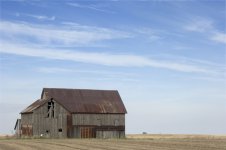Ben Z said:
I've always wondered why some people think the Leica was actually designed for (and moreover, from some philosophical point should be limited to) street photography alone.
Ben, I don't think anyone's said that the Leica should be limited to street photography, and it wasn't designed for street photography; it was designed to make test exposures for movies. Certainly the rangefinder is better suited to street photography than an SLR, a Rollei or a Hasselblad, or an 8 x 10 view camera. On the other hand some people have done quite satisfactory landscape with a 35mm, just as Eugene Atget did some pretty fine street photography with what was approximately an 8 x 10 stand camera. You can drive a nail with the handle of a screwdriver, but it's not a very efficient way to do it. If you compare a contact print from an 11 x 14 camera with an 11 x 14 print from a 35mm camera or a 10 megapixel digital rangefinder the difference is pretty obvious. After working a bit with some of Jaap's .DNGs, I'm convinced that Leica did a fabulous job with M8 image quality, in spite of the high-range 8 bit conversions. But I wouldn't stack the results against even medium format digital, much less large format film.
Looking at .JPEGs of this stuff on a computer monitor doesn't really tell you much of anything, but here are two very different shots that help me say what I'm trying to say.
The first is from an R-D1. I can't say I'd never have been able to shoot this picture with a D2X, but considering that I had less than a second to aim and shoot it'd have been very unlikely. I'm sure it would have been of better technical quality if I'd been able to shoot it with an M8, but for this kind of picture, technical quality is nice, but secondary.
The second picture isn't landscape exactly, but it's close to that. I shot it with a D2X. The 16 bit (14 useful) .NEF file off the camera is over 19 megabytes with no 8 bit conversions or compression. It would have been better if I'd made this shot with an 8 x 10 view camera or a Hasselblad, but I'll stack it up against any digital rangefinder image currently available.
Dan Suskin certainly made some astonishing photographs in the Namib. I suggested to him that he make some large prints and try to find a gallery for them. If he hangs them I doubt anyone's going to ask what kind of camera he shot them with. We all fuss a lot about equipment but the only thing that matters in the end is the print.



